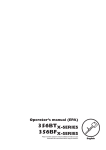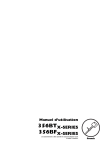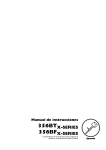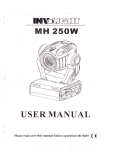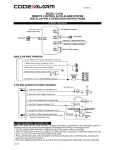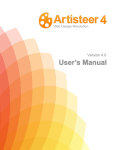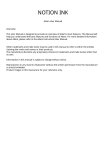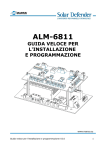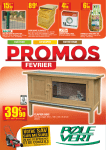Download Husqvarna 356BT Blower User Manual
Transcript
Operator′s manual
356BTX-SERIES
356BFX-SERIES
Please read the operator’s manual carefully and make sure you
understand the instructions before using the machine.
English
KEY TO SYMBOLS
Symbols
Other symbols/decals on the machine refer to special
certification requirements for certain markets.
WARNING! The machine can be a dangerous
tool if used incorrectly or carelessly, which can
cause serious or fatal injury to the operator or
others.
Switch off the engine by moving the stop
switch to the STOP position before carrying
out any checks or maintenance.
Please read the operator’s manual carefully
and make sure you understand the
instructions before using the machine.
Always wear:
•
Hearing protection
•
Approved eye protection
Always wear protective gloves.
Regular cleaning is required.
Visual check.
This product is in accordance with applicable
EC directives.
Protective goggles or a visor must be worn.
Gloves should be worn when necessary.
The blower can forcibly throw objects that
can bounce back. This can result in
serious eye injuries if the recommended
safety equipment is not used.
The blower operator must ensure that
no people or animals come closer
than 15 metres. When several
operators are working at the same
site a safety distance of at least 15 metres must be in effect.
A breathing mask should be used when
there is a risk of dust.
Noise emission to the environment according
to the European Community’s Directive. The
machine’s emission is specified in chapter
Technical data and on label.
2 – English
CONTENTS
Contents
KEY TO SYMBOLS
Symbols .......................................................................
CONTENTS
Contents ......................................................................
Note the following before starting: ................................
SAFETY INSTRUCTIONS
Personal protective equipment .....................................
Machine′s safety equipment ........................................
Checking, maintaining and servicing the machine′s
safety equipment ..........................................................
General safety precautions ..........................................
General working instructions .......................................
WHAT IS WHAT?
What is what on the blower? ........................................
ASSEMBLY
Assembling the blow pipe and control handle ..............
FUEL HANDLING
Fuel ..............................................................................
Fuelling ........................................................................
STARTING AND STOPPING
Starting and stopping ...................................................
MAINTENANCE
Carburettor ...................................................................
Muffler ..........................................................................
Cooling system ............................................................
Spark plug ....................................................................
Air filter .........................................................................
Maintenance schedule .................................................
TECHNICAL DATA
Technical data ..............................................................
EC-declaration of conformity ........................................
Note the following before starting:
Please read the operator’s manual carefully.
2
Long-term exposure to noise can result in permanent hearing
impairment. So always use approved hearing protection.
3
3
4
4
!
5
6
7
9
10
!
WARNING! Under no circumstances may the
design of the machine be modified without
the permission of the manufacturer. Always
use genuine accessories. Non-authorized
modifications and/or accessories can result
in serious personal injury or the death of the
operator or others.
WARNING! A blower is a dangerous tool if
used carelessly or incorrectly and can cause
serious, even fatal injuries. It is extremely
important that you read and understand the
contents of this Operator’s manual.
11
11
Husqvarna AB has a policy of continuous product
development and therefore reserves the right to modify the
design and appearance of products without prior notice.
12
The machine is only designed for blowing lawns, pathways,
asphalt roads and the like.
13
14
14
14
15
16
17
18
English
–3
SAFETY INSTRUCTIONS
Personal protective equipment
!
!
•
WARNING! You must use approved personal
protective equipment whenever you use the
machine. Personal protective equipment
cannot eliminate the risk of injury but it will
reduce the degree of injury if an accident
does happen. Ask your dealer for help in
choosing the right equipment. Please read
the operator’s manual carefully and make
sure you understand the instructions before
using the machine.
WARNING! Listen out for warning signals or
shouts when you are wearing hearing
protection. Always remove your hearing
protection as soon as the engine stops.
Gloves should be worn when necessary.
•
A breathing mask should be used when there is a risk of
dust.
•
Always have a first aid kit nearby.
Machine′s safety equipment
This section describes the machine′s safety equipment, its
purpose, and how checks and maintenance should be carried
out to ensure that it operates correctly. See the ”What is
what?” section to locate where this equipment is positioned
on your machine.
!
•
Wear hearing protection that provides adequate noise
reduction.
WARNING! Never use a machine that has
faulty safety equipment! Carry out the
inspection, maintenance and service
routines listed in this section.
Stop switch
Use the stop switch to switch off the engine.
•
Always wear approved eye protection. If you use a visor
then you must also wear approved protective goggles.
Approved protective goggles must comply with standard
ANSI Z87.1 in the USA or EN 166 in EU countries.
Blows from branches or objects that are thrown can
damage the eyes.
Vibration damping system
Your machine is equipped with a vibration damping system
that is designed to minimize vibration and make operation
easier.
•
•
Wear sturdy, non-slip boots.
Wear clothes made of a strong fabric and avoid loose
clothing that can catch on twigs and branches. Always
wear heavy, long pants. Do not wear jewellery, shorts
sandals or go barefoot. Secure hair so it is above shoulder
level.
4 – English
!
WARNING! Overexposure to vibration can
lead to circulatory damage or nerve damage
in people who have impaired circulation.
Contact your doctor if you experience
symptoms of overexposure to vibration.
Such symptoms include numbness, loss of
feeling, tingling, pricking, pain, loss of
strength, changes in skin colour or
condition. These symptoms normally appear
in the fingers, hands or wrists. The risk
increases at low temperatures.
SAFETY INSTRUCTIONS
Muffler
The muffler is designed to keep noise levels to a minimum
and to direct exhaust fumes away from the user.
Checking, maintaining and servicing
the machine′s safety equipment
!
In countries that have a warm and dry climate there is a
significant risk of fire. Consequently, we have equipped the
muffler with a spark arrestor mesh mounted inside the muffler.
WARNING! All servicing and repair work on
the machine requires special training. This is
especially true of the machine′′s safety
equipment. If your machine fails any of the
checks described below you must contact
your service agent. When you buy any of our
products we guarantee the availability of
professional repairs and service. If the
retailer who sells your machine is not a
servicing dealer, ask him for the address of
your nearest service agent.
Stop switch
•
Start the engine and make sure the engine stops when
you move the stop switch to the stop setting.
For mufflers it is very important that you follow the instructions
on checking, maintaining and servicing your machine. See
instructions under the heading Checking, maintaining and
servicing the machine’s safety equipment.
!
WARNING!
Bear in mind that: Engine exhaust fumes
contain carbon monoxide, which can cause
carbon monoxide poisoning. For this reason
you should not start or run the machine
indoors, or anywhere that is poorly
ventilated.
Vibration damping system
•
Check the vibration damping units regularly for cracks or
deformation. Replace them if damaged.
•
Check that the vibration damping element is undamaged
and securely attached.
The exhaust fumes from the engine are hot
and may contain sparks which can start a
fire. Never start the machine indoors or near
combustible material!
!
WARNING! The inside of the muffler contain
chemicals that may be carcinogenic. Avoid
contact with these elements in the event of a
damaged muffler.
Muffler
•
Never use a machine that has a faulty muffler.
English
–5
SAFETY INSTRUCTIONS
•
Regularly check that the muffler is securely attached to
the machine.
•
The muffler on your machine is equipped with a spark
arrestor mesh; this must be cleaned regularly. See the
heading Muffler in the Maintenance chapter. A blocked
mesh will cause the engine to overheat and may lead to
serious damage.
•
•
Fuel safety
•
Always use a fuel container with an anti-spill valve.
•
Never refuel the machine while the engine is running.
Always stop the engine and let it cool for a few minutes
before refuelling.
•
Make sure there is plenty of ventilation when refuelling or
mixing fuel (petrol and 2-stroke oil).
•
Avoid all skin contact with fuel. Fuel is a skin irritant and
may even cause skin changes.
•
Move the machine at least 3 m from the refuelling point
before starting it.
•
Never start the machine:
Never use a muffler with a defective spark arrestor mesh.
!
WARNING! Never use a machine with faulty
safety equipment. The machine’s safety
equipment must be checked and maintained
as described in this section. If your machine
fails any of these checks contact your
service agent to get it repaired.
Place the machine on the ground, press the machine
body against the ground with your left hand (NOTE! Not
your foot). Now grasp the starter handle with your right
hand and then pull quickly and firmly.
General safety precautions
General
•
Never use the machine if you are tired, if you have drunk
alcohol, or if you are taking medication that could affect
your vision, your judgement or your co-ordination.
•
Wear personal protective equipment. See instructions
under the heading Personal protective equipment.
•
Never use a machine that has been modified in any way
from its original specification.
•
Never use a machine that is faulty. Carry out the checks,
maintenance and service instructions described in this
manual. Some maintenance and service measures must
be carried out by trained and qualified specialists. See
instructions under the heading Maintenance.
•
•
All covers and guards must be fitted before starting.
Ensure that the spark plug cap and ignition lead are
undamaged to avoid the risk of electric shock.
The blower operator must ensure that no people or
animals come closer than 15 metres. When several
operators are working at the same site a safety distance
of at least 15 metres must be in effect.
Starting
•
Never start the machine indoors. Exhaust fumes can be
dangerous if inhaled.
•
Observe the surroundings and ensure that no people or
animals can come into contact with the blower.
6 – English
-
If you have spilt fuel on it. Wipe off the spillage and
allow remaining fuel to evaporate.
-
If you have spilt fuel on yourself or your clothes,
change your clothes. Wash any part of your body that
has come in contact with fuel. Use soap and water.
-
If the machine is leaking fuel. Check regularly for leaks
from the fuel cap and fuel lines.
Transport and storage
•
Store and transport the machine and fuel so that there is
no risk of any leakage or fumes coming into contact with
sparks or naked flames, for example, from electrical
machinery, electric motors, electrical relays/switches or
boilers.
•
When storing and transporting fuel always use approved
containers intended for this purpose.
•
When storing the machine for long periods the fuel tank
must be emptied. Contact your local petrol station to find
out where to dispose of excess fuel.
SAFETY INSTRUCTIONS
•
Ensure the machine is cleaned and that a complete
service is carried out before long-term storage.
!
IMPORTANT! This section considers basic safety rules
when working with blowers. If you encounter a situation
where you are uncertain how to proceed you should ask an
expert. Contact your dealer or your service workshop. Avoid
all usage which you consider to be beyond your capability.
WARNING! Take care when handling fuel.
Bear in mind the risk of fire, explosion and
inhaling fumes.
Adjusting the harness
!
General working instructions
WARNING! The harness must always be
worn when working with the machine.
Failure to do so means you will be unable to
manoeuvre safely and this can result in
injury to yourself or others.
Show consideration to persons in your surroundings by
avoiding using the machine at unsuitable times, such as late
in the evening or early in the morning. Read through and
follow the simple directions so that you disturb your
surroundings as little as possible.
•
Use the blower with the lowest possible throttle. It is
seldom necessary to use full throttle, and many work
procedures can be done at half throttle. A lower throttle
means less noise and less dust, and it is also easier to
keep control over the rubbish collected together/moved.
•
Use a rake or a brush to release rubbish stuck to the
ground.
•
Hold the opening of the blower as close to the ground as
possible.
•
Observe your surroundings. Direct the blower away from
people, animals, play areas, and cars etc.
•
Clean up afterwards. Make sure that you have not blown
rubbish into someone’s garden.
A correctly adjusted harness and machine significantly
facilitates the work. Adjust the harness to give the best
working position.
Tighten the side straps so that the pressure is evenly
distributed across the shoulders.
Basic safety rules
•
No unauthorised persons or animals may be present in
the working area, which is 15 metres.
•
The powerful currents of air can move objects at such a
speed that they can bounce back and cause serious eye
injuries.
•
Do not direct the air jet towards people or animals.
•
Stop the engine before assembling or dismantling
accessories or other parts.
•
Do not use the machine in bad weather, such as dense
fog, heavy rain, strong wind, intense cold, etc. Working in
bad weather is tiring and can lead to dangerous
conditions, e.g. slippery surfaces.
Place the hip strap over the hip and not too far down on the
stomach. Tighten the hip strap so that you feel the weight of
the blower resting on your hip.
English
–7
SAFETY INSTRUCTIONS
•
Make sure you can move and stand safely. Check the area
around you for possible obstacles (roots, rocks, branches,
ditches, etc.) in case you have to move suddenly. Take
great care when working on sloping ground.
•
Never put the machine down with the engine running
unless you have it in clear sight.
•
Engine exhaust fumes contain carbon monoxide, which
can cause carbon monoxide poisoning. For this reason
you should not start or run the machine indoors, or
anywhere that is poorly ventilated.
•
•
The blower must not be used while on a ladder or
scaffolding.
CAUTION! Do not use the machine unless you are able to
call for help in the event of an accident.
Basic working techniques
!
!
•
WARNING! Watch out for thrown objects.
Always wear eye protection. Stones,
rubbish, etc. can be thrown up into the eyes
causing blindness or serious injury. Keep
unauthorised persons at a distance.
Children, animals, onlookers and helpers
should be kept outside the safety zone of 15
m. Stop the machine immediately if anyone
approaches.
WARNING! Always stop the engine before
cleaning.
The speed of the air jet is regulated by means of the
throttle. Select the speed best suited for respective tasks.
(356 BTX-SERIES)
You can set the throttle position using the ”stop switch”
and by doing so not need to hold your finger on the throttle
all the time you are using the blower. Full throttle is
obtained when the control is held back fully.
8 – English
•
Check that the air intake is not blocked, for example, by
leaves or rubbish. A clogged air intake reduces the
machine’s blowing capacity and increases the engine’s
working temperature, which can result in engine failure.
Stop the engine and remove the object.
•
Be aware of the wind direction. Work with the wind to
make your work easier.
•
Using the blower to move large piles is time consuming
and creates unnecessary noise.
•
When work is finished the machine should be stored
vertically.
WHAT IS WHAT?
What is what on the blower?
1
Outer cover
12 Muffler
2
Harness
13 Spark plug
3
Outlet pipe
14 Air purge
4
Bellows with guard
15 Choke control
5
Stop switch with throttle position setting
16 Fuel tank
6
Control handle/Operating handle
17 Adjuster screws carburettor
7
Throttle control (356 BT)
18 Air filter
8
Control pipe
19 Combination spanner
9
Intermediate pipe
20 Handlebar (Accessory)
10 Blow pipe
21 Flat nozzle (Accessory)
11 Starter handle
22 Operator′s manual
English
–9
ASSEMBLY
Assembling the blow pipe and
control handle
•
•
Disassemble the knob from the control handle and push
the holder on to the control pipe.
Loosen the two screws on the fan’s outlet pipe and
remove the two wear ring halves located on the outlet
pipe.
Assemble the knob and adjust position and angle to
achieve comfortable working position, tighten the knob.
Attach the cabling in the cover.
•
Place these on the pipe bend so that the guide on the
wear ring halves aligns with the slot on the pipe bend.
Connect the intermediate pipe and air nozzle. Push the pipes
together and turn them so they lock in relation to one another.
•
Refit the pipe bend with the wear halves in the fan’s outlet
pipe.
Make sure the holes in the wear ring halves align with the
screws that are used to secure the halves in the pipe
bend.
Attachments
Handlebar
Disassemble the intermediate pipe. Disassemble the knob
from the holder and puch the holder on to the holder pipe.
Assemble the knob and tighten.
Also pay attention to the stops located on the pipe bend
and the fan’s outlet pipe. Ensure that the stop on the pipe
bend comes in front of the stop on the outlet pipe.
Assemble the intermediate pipe.
•
Refit the bolts and tighten well.
Check that the control pipe is in the right position and can
rotate equally in both directions.
Flat nozzle
•
10 – English
If higher air speed is required, the round blow pipe is
replaced by the flat nozzle.
FUEL HANDLING
Fuel
CAUTION! The machine is equipped with a two-stroke engine
and must always been run using a mixture of petrol and twostroke engine oil. It is important to accurately measure the
amount of oil to be mixed to ensure that the correct mixture is
obtained. When mixing small amounts of fuel, even small
inaccuracies can drastically affect the ratio of the mixture.
!
•
Always start by filling half the amount of the petrol to be
used. Then add the entire amount of oil. Mix (shake) the
fuel mixture. Add the remaining amount of petrol.
•
Mix (shake) the fuel mixture thoroughly before filling the
machine’s fuel tank.
•
Do not mix more than one month’s supply of fuel at a time.
•
If the machine is not used for some time the fuel tank
should be emptied and cleaned.
WARNING! Always ensure there is adequate
ventilation when handling fuel.
Petrol
CAUTION!
Always use a good quality petrol/oil mixture (at least 90
octane).
Fuelling
!
•
•
WARNING! Taking the following precautions,
will lessen the risk of fire:
The lowest recommended octane rating is 90. If you run
the engine on a petrol with a lower octane rating than 90
this can cause knocking. This leads to an increased
engine temperature, which can result in serious engine
damage.
Do not smoke or place hot objects near fuel.
When working at continuous high revs a higher octane
rating is recommended.
When refuelling, open the fuel cap slowly so
that any excess pressure is released gently.
Always shut off the engine before refuelling.
Always stop the engine and let it cool for a
few minutes before refuelling.
Two-stroke oil
Tighten the fuel cap carefully after refuelling.
•
Always move the machine away from the
refuelling area before starting.
For best results and performance use HUSQVARNA twostroke oil, which is specially formulated for our two-stroke
engines. Mixture 1:50 (2%).
•
If HUSQVARNA two-stroke oil is not available, you may
use another two-stroke oil of good quality that is intended
for air cooled engines. Contact your dealer when selecting
an oil. Mixing ratio 1:33 (3%).
•
Never use two-stroke oil intended for water-cooled
outboard engines, sometimes referred to as outboard oil.
•
Never use oil intended for four-stroke engines.
Petrol, litre
Two-stroke oil, litre
2% (1:50)
3% (1:33)
5
0,10
0,15
10
0,20
0,30
15
0,30
0,45
20
0,40
0,60
•
Move the machine at least 3 m from the refuelling point
before starting it.
•
Clean the area around the fuel cap. Contamination in the
tank can cause operating problems.
•
Ensure that the fuel is well mixed by shaking the container
before filling the tank.
Mixing
•
Always mix the petrol and oil in a clean container intended
for fuel.
English
– 11
STARTING AND STOPPING
Starting and stopping
Starting
Hold the body of the machine on the ground using your left
hand (CAUTION! Not with your foot!).
!
WARNING! Always move the machine away
from the refuelling area before starting.
Place the machine on a flat surface.
Grip the starter handle, slowly pull out the cord with your right
hand until you feel some resistance (the starter pawls grip),
now quickly and powerfully pull the cord.
Make sure no unauthorised persons are in
the working area, otherwise there is a risk of
serious personal injury. The safety distance
is 15 metres.
The machine may only be started in its
complete design. If the machine is started
without all the guards fitted there is a risk of
personal injuries.
Cold engine
Ignition: Set the stop switch to the start position. Start
position is achieved by moving the stop switch slightly
backwards (356BT) or downwards (356BF) until the stop
switch clicks into start position.
Never twist the starter cord around your hand.
Repeat pulling the cord until the engine starts. When the
engine starts, return choke control to run position.
CAUTION! Do not pull the starter cord all the way out and do
not let go of the starter handle when the cord is fully extended.
This can damage the machine.
Stopping
The engine is stopped by moving the stop switch to the stop
position.
It is not allowed to set the stop switch in full throttle position.
Choke: Set the choke control in the choke position.
Primer bulb: Press the primer bulb repeatedly until fuel
begins to fill the bulb. The bulb need not be completely filled.
Warm engine
Use the same starting procedure as for a cold engine but
without setting the choke control in the choke position.
12 – English
MAINTENANCE
Carburettor
Conditions
Your Husqvarna product has been designed and
manufactured to specifications that reduce harmful
emissions. After the engine has used 8-10 tanks of fuel the
engine will be run-in. To ensure that it continues to run at peak
performance and to minimise harmful exhaust emissions
after the running-in period, ask your dealer/service workshop
(who will have a rev counter at their disposal) to adjust your
carburettor.
•
Before any adjustments are made, make sure that the air
filter is clean and the air filter cover is fitted. If you adjust
the carburettor when the air filter is dirty it will result in a
leaner mixture when the filter is finally cleaned. This can
lead to serious engine damage.
•
Carefully turn both jets, L and H, so that they are midway
between fully screwed in and fully screwed out.
•
Do not attempt to adjust the L and H jets beyond either
stop as this could cause damage.
•
Now start the machine according to the starting
instructions and let it warm up for 10 minutes.
Function
The carburettor governs the engine’s speed via the throttle
control. Air and fuel are mixed in the carburettor. The air/fuel
mixture is adjustable. Correct adjustment is essential to get
the best performance from the machine.
Low speed jet L
If the engine run unstable on idle, adjest the L jet clockwise
respectively anticlockwise until the engine runs smoothly.
Adjusting the carburettor means that the engine is adapted to
local operating conditions, e.g. climate, altitude, petrol and the
type of 2-stroke oil.
The carburettor has three adjustment controls:
•
L = Low speed jet
•
H = High speed jet
•
T = Idle adjustment screw
L
Fine adjustment of the idle speed T
T
Adjust the idle speed screew T clockwise respectively anticlockwise until an idle speed of 2300 rpm is reached.
H
The L and H-jets are used to adjust the supply of fuel to match
the rate that air is admitted, which is controlled with the
throttle. If they are screwed clockwise the air/fuel ratio
becomes leaner (less fuel) and if they are turned anticlockwise the ratio becomes richer (more fuel). A lean mixture
gives a higher engine speed and a rich mixture gives a lower
engine speed.
High speed jet H
Apply full throttle. Adjust the H jet clockwise respectively anticlockwise until a racing speed of 5800-6000 rpm is reached
and the engine runs smoothly.
The T-screw regulates the throttle setting at idle speed. If the
T-screw is turned clockwise this gives a higher idle speed;
turning it anti-clockwise gives a lower idle speed.
Basic setting
The basic carburettor settings are adjusted during testing at
the factory. The basic setting is richer than the optimal setting
and should be maintained for the first few hours the machine
is in use. The carburettor should then be finely adjusted. Fine
adjustment should be carried out by a skilled technician.
Fine adjustment
When the machine has been ”run-in” the carburettor should
be finely adjusted. The fine adjustment should be carried out
by a qualified person. First adjust the L-jet, then the idling
screw T and then the H-jet.
Correctly adjusted carburettor
When the carburettor is correctly adjusted the machine will
accelerate without hesitation and burble a little at maximum
speed. If the low speed jet L is set too lean it may cause
starting difficulties and poor acceleration.
If the high speed jet H is set too lean it will result in less power,
less performance, poor acceleration and/or damage to the
engine.
If both the L and H jets are set too rich it will results in
acceleration problems or too low a working speed.
English
– 13
MAINTENANCE
Muffler
Cooling system
The muffler is designed to reduce the noise level and to direct
the exhaust gases away from the operator. The exhaust
gases are hot and can contain sparks, which may cause fire
if directed against dry and combustible material.
To keep the working temperature as low as possible the
machine is equipped with a cooling system.
The cooling system consists of:
4
1
2
3
5
The muffler is equipped with a special spark arrestor mesh.
The spark arrestor mesh should be cleaned once a month.
This is best done with a wire brush.
To remove the spark arrestor mesh proceed as follows:
Remove the screws to the capillary tube and exhaust pipe.
1
Air intake on the underside of the blower.
2
Nozzle for cooling the cylinder
3
Cooling fins on the cylinder.
4
Cooling air conductor (directs cold air over the cylinder).
5
Emergency cooling nozzle
Clean the cooling system with a brush once a week, more
often in demanding conditions. A dirty or blocked cooling
system results in the machine overheating which causes
damage to the piston and cylinder. Check that the nozzles are
not blocked.
Loosen the muffler’s 2 screws and remove the muffler.
Spark plug
The spark plug condition is influenced by:
Pull out the spark arrestor mesh and clean using a wire brush.
Replace the spark arrestor mesh if it is defective.
•
Incorrect carburettor adjustment.
•
An incorrect fuel mixture (too much or incorrect type of
oil).
•
A dirty air filter.
These factors cause deposits on the spark plug electrodes,
which may result in operating problems and starting
difficulties.
CAUTION! Never use a machine with a defective muffler.
!
WARNING! The muffler gets very hot during
use and remain so for some time after
stopping. This also applies at idle speed.
Contact can result in burns to the skin.
Remember the risk of fire!
If the machine is low on power, difficult to start or runs poorly
at idle speed: always check the spark plug first before taking
any further action. If the spark plug is dirty, clean it and check
that the electrode gap is 0.5 mm. The spark plug should be
replaced after about a month in operation or earlier if
necessary.
CAUTION! Always use the recommended spark plug type!
Use of the wrong spark plug can damage the piston/cylinder.
14 – English
MAINTENANCE
Air filter
Ensure that the filter is soaked in oil before refitting it.
The air filter must be regularly cleaned to remove dust and dirt
in order to avoid:
•
Carburettor malfunctions
•
Starting problems
•
Loss of engine power
•
Unnecessary wear to engine parts.
•
Excessive fuel consumption.
Clean the filter every 40 hours, or more regularly if conditions
are exceptionally dusty.
An air filter that has been in use for a long time cannot be
cleaned completely. The filter must therefore be replaced with
a new one at regular intervals. A damaged air filter must
always be replaced.
Oiling the air filter
Always use HUSQVARNA filter oil, art. no. 531 00 60-76. The
filter oil contains a solvent to make it spread evenly through
the filter. You should therefore avoid skin contact.
Put the filter in a plastic bag and pour the filter oil over it.
Knead the plastic bag to distribute the oil. Squeeze the
excess oil out of the filter inside the plastic bag and pour off
the excess before fitting the filter to the machine. Never use
common engine oil. This would drain through the filter quite
quickly and collect in the bottom.
Avoid contact with hot surfaces on muffler, cylinder etc.
Contact can result in burns to the skin.
Cleaning the air filter
Dismantle the outer cover with the help of the four fasteners
holding the outer cover.
Loosen the two fasteners holding the air filter cowling and
remove the filter. Wash the filter clean in warm, soapy water.
The air filter is fitted in the air filter cowling.
English
– 15
MAINTENANCE
Maintenance schedule
Monthly maintenance
1
Below you will find some general maintenance instructions. If
you need further information please contact your service
workshop.
3
2
L
H
T
Daily maintenance
1
4
356 BF
2
5
6
356 BT
4
3
5
1
Check the fuel filter and the fuel hose. Replace if
necessary.
2
Check all cables and connections.
3
Replace the spark plug. Check that the spark plug is fitted
with a suppressor.
4
Check and clean the spark arrestor mesh on the muffler.
5
Check that the vibration damping elements are not
damaged.
6
Clean the fuel tank.
356 BF
356 BT
L
H
T
1
Clean the outside of the machine.
2
Check that the throttle control functions safely.
3
Check that the stop switch works correctly.
4
Check that nuts and screws are tight.
5
Check that there are no fuel leaks.
Weekly maintenance
1
Clean the air filter. Replace if necessary.
2
Clean the outside of the spark plug. Remove and check
the electrode gap. Adjust the gap to 0.5 mm or change the
spark plug.
3
Clean the cooling system.
16 – English
TECHNICAL DATA
Technical data
Technical data
356BTx
356BFx
51,7
51,7
Engine
Cylinder displacement, cm3
Cylinder bore, mm
44
44
Stroke, mm
34
34
Idle speed, rpm
2300
2300
Max. engine output, acc. to ISO 8893, kW/ rpm
2,4/6000
2,4/6000
Catalytic converter muffler
No
No
Speed-regulated ignition system
Yes
Yes
Manufacturer/type of ignition system
Ducati ET
Ducati ET
Spark plug
NGK BPMR 7A
NGK BPMR 7A
Electrode gap, mm
0,5
0,5
Manufacturer/type of carburettor
Zama EL27
Zama EL27
Fuel tank capacity, litre
1,5
1,5
10,4
10,4
Sound power level, measured dB(A)
102
102
Sound power level, guaranteed LWA dB(A)
104
104
Equivalent noise pressure level at the operator’s ear, measured
according to EN/ISO 11806 and ISO 7917, dB(A), min./max.:
88
91
With flat nozzle (accessory)
90
89
At idle, right handle:
1,3
1,7
At max. speed, right handle:
4,2
4,3
At idle, left/right handles:
1,7/2,5
1,3/1,8
At max. speed, left/right handles:
2,5/4,8
1,7/3,0
Ignition system
Fuel and lubrication system
Weight
Weight without fuel, kg
Noise emissions
(see note 1)
Noise levels
(see note 2)
Vibration levels
Vibration levels at handles, measured according to EN/ISO 11806
and ISO 7916, m/s2
With handle (accessory)
Fan performance
Max. air velocity vith standard nozzle, m/s:
79
79
Air flow with standard nozzle, m3/min
13,3
13,3
Max air velocity with flat nozzle (Accessory), m/s:
90
90
Air flow with flat nozzle (accessory), m3/min:
13,0
13,0
Note 1: Noise emissions in the environment measured as sound power (LWA) in conformity with EC directive 2000/14/EC.
Note 2: Equivalent sound pressure level is calculated as the time-weighted energy total for sound pressure levels under various
working conditions with the following time distribution: 1/2 idling and 1/2 max speed.
English
– 17
TECHNICAL DATA
EC-declaration of conformity
(Applies to Europe only)
Husqvarna AB, SE-561 82 Huskvarna, Sweden, tel +46-36-146500, declares under sole responsibility that the blowers Husqvarna
356 BT X-SERIES and 356 BF X-SERIES with serial numbers dating 2005 and onwards (the year is clearly stated on the rating
plate, followed by the serial number), comply with the requirements of the COUNCIL’S DIRECTIVE:
of June 22, 1998 ”relating to machinery” 98/37/EC, annex IIA.
of May 3, 1989 ”relating to electromagnetic compatibility” 89/336/EEC, and applicable supplements.
of May 8, 2000 ”relating to the noise emissions in the environment” 2000/14/EC.
For information relating to noise emissions, see the chapter Technical data. The following standards have been applied: EN ISO
11200-2, CISPR 12:2001, EN ISO 11806.
SMP Svensk Maskinprovning AB, Fyrisborgsgatan 3, SE-754 50 Uppsala, Sweden, has performed voluntary type examination on
behalf of Husqvarna AB. The certificates are numbered: SEC/04/1034, 01/012/003
Huskvarna January 3, 2005
Bo Andréasson, Development manager
18 – English
´®z+H4r¶6{¨
´®z+H4r¶6{¨
1140208-26
´®z+H4r¶6{¨
´®z+H4r¶6{¨
2005-01-13




















